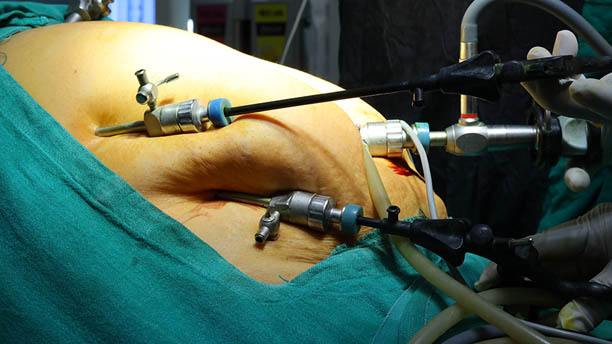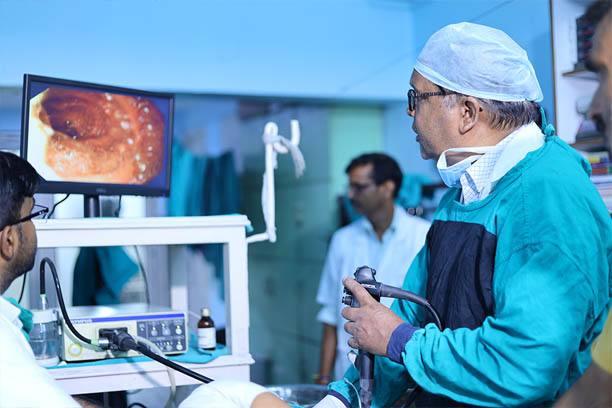Gall Bladder Surgery in Pilibhit
- Home
- Departments
- General & Lap. Surgery
- Gall Bladder
Gallbladder Removal – Lap Chole
Better known as Laparoscopic Cholecystectomy; it is the surgical removal of the gallbladder.Cholecystectomy serves as a common approach for addressing symptomatic gallstones and various gallbladder-related ailments. Laparoscopic cholecystectomy, a minimally invasive procedure, is employed for gallbladder removal. This method proves highly beneficial for patients experiencing inflammation, pain, or infection due to gallbladder stones.
When comparing laparoscopic cholecystectomy to open cholecystectomy, the former is notably less invasive. The procedure of laparoscopic cholecystectomy entails making a few small incisions, often allowing patients to return home on the same day and resume their regular daily activities relatively soon.
The alternative method for gallbladder removal necessitates a larger incision. In this procedure, the surgeon creates several small incisions on the right side of the patient's abdomen. Through one of these incisions, a slender tube known as a laparoscope equipped with a camera on one end is inserted into the abdomen. Utilizing the camera's feed, the patient's gallbladder is projected onto a screen, allowing for its removal through an additional small incision.
Who needs to have gallbladder removal?
The formations of crystals within the gallbladder are referred to as gallstones. These stones have the potential to obstruct the normal flow of bile from the gallbladder into the digestive system, leading to gallbladder inflammation known as cholecystitis. Additionally, gallstones can trigger movement within other areas of the body, causing intense pain.

The symptoms of gallstones are listed below:
- Having fever
- Bloated feeling
- Developing jaundice
- Suffering with nausea
- Pain in the right side of the abdomen, reaching up to the back or the shoulder.
A laparoscopic cholecystectomy is quite helpful for people suffering with gallstones which is causing them pain and infection.
What are the benefits of gallbladder removal?
Gallbladder removal proves highly advantageous for individuals afflicted by gallstones. This procedure alleviates pain, resolves infections stemming from gallstones, and serves as a preventive measure against their recurrence.
Neglecting the appropriate treatment for gallstones can lead to intense pain and worsening infections that may persist. Additionally, in cases where the gallbladder ruptures due to various factors, it can result in a life-threatening situation.
What are the benefits of laparoscopic cholecystectomy?
The surgeon who will be operating the gallbladder will choose the surgery— open or laparoscopic cholecystectomy, is the right one for you based on the conditions of the stone.

The laparoscopic procedure has several benefits:
- Causes less pain.
- Has a lower risk of complications.
- Results into quick recovery and returning back to daily life activities.
- Cause small wounds and scars
Gallbladder CBD (Common Bile Duct)
Gallstones in the bile ductAlso referred to as bile duct stones, specifically gallstones within the bile duct, choledocholithiasis is characterized by the presence of a gallstone within the common bile duct. This small tube serves to transport bile from the pear-shaped organ located below the liver in the upper right side of the abdomen, namely the gallbladder, to the intestine. Typically, these stones either remain within the gallbladder or traverse the common bile duct without obstruction.
What are the symptoms?
Gallstones within the bile duct often go undetected, as they may remain asymptomatic for a significant duration, even extending to years. However, if a stone within the duct becomes lodged and causes a blockage, symptoms may manifest -

the following symptoms are experienced:
- Pain in the right upper or middle upper abdomen
- Suffering with fever
- Developing jaundice
- Losing desire to eat
- Suffering with nausea and vomiting
- Excreting clay-coloured stools
The pain attributed to gallstones can vary, ranging from sporadic to prolonged. Occasionally, you might encounter mild discomfort that can escalate into intense pain, potentially necessitating immediate medical attention. In certain instances, severe symptoms can be mistaken for a cardiac event, such as a heart attack.
The presence of a gallstone in the bile duct can lead to infection, which has the potential to rapidly spread bacteria. This infection could extend to the liver, resulting in a life-threatening condition. Additional potential complications include biliary cirrhosis and pancreatitis.
General & Lap. Surgery
Headed by Dr. P. D. Singh, one of the finest surgeon in the region for General & Laparoscopic Surgeries with best in class and advance equipment.
Urological Surgeries
Dr. Rohit Singh at P.D.S. Hospital performs highly advanced urological procedures in the Kamayun and Rohilkhand region.
Training Programs
Our aim is to educate the new and practicing doctors, in various specialties, like laproscopic surgeries and urology related surgeries.
